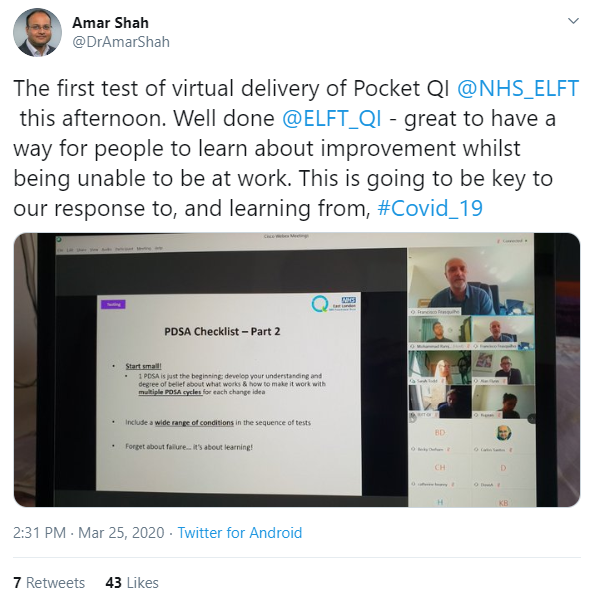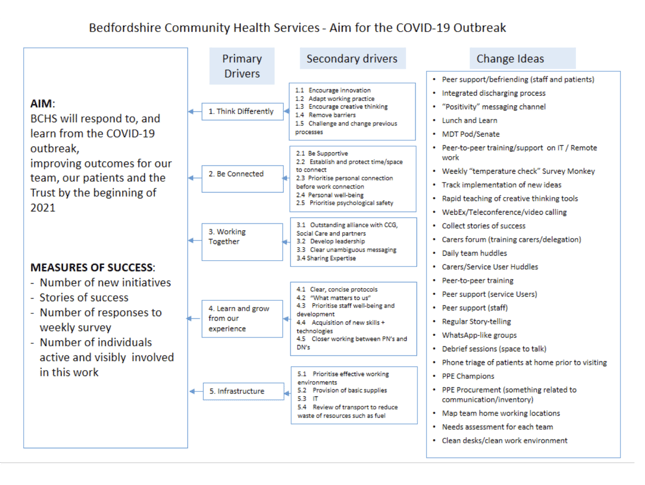Start improving with Life QI today
Full access to all Life QI features and a support team excited to help you. Quality improvement has never been easier.

Organisation already using Life QI?
Sign-up

As QI professionals and the frontline staff working on improvement programmes have become wholly focused on the COVID-19 response, existing QI programmes are being rapidly halted. During the last two weeks of March we spoke with QI teams in 9 countries, the vast majority telling us their programmes had been temporarily suspended.
This has not happened across the board though. Some programmes are continuing. We have seen this both on internal hospital QI projects, and on multi-organisation collaboratives. Albeit many have said the pace of testing and data collection is expected to slow. A great example of a programme still taking place, and in fact launching during this time is IHI’s global network for Joy in Work, the first learning session taking place on 26 March – virtually rather than in person as originally planned.
For those needing to halt their programmes, Healthcare Improvement Scotland have produced guidance on hibernating programmes. For those using online platforms, like Life QI, they are using this time to ensure projects are fully up to date. Bringing projects up to date will ensure everyone is on the same page when it comes to re-igniting the project so is a great thing to do in this interim period if you have a few minutes. To help with this we have prepared our top 4 tips for keeping your project up to date.
Much like the improvement programmes themselves, the training programmes being run within and across organisations are being paused and new cohorts delayed. For example, the internationally renowned Scottish Quality and Safety Fellowship run by NHS Education for Scotland has halted recruitment to cohort 13 which was due to begin in September.
Pausing improvement training has been a common response and is helping free up the time of both clinical and other healthcare staff to focus on COVID-19 activities.
For teams who are carrying on with running QI training programmes, most of which have always been run in person, they are now faced with needing to rapidly switch to virtual training sessions. This presents challenges on a number of fronts: Does the existing learning material work virtually? How to keep participants engaged during virtual sessions? What kind of interaction should be expected? What technology to use to facilitate sessions?
Some have adapted quickly to this. ELFT have already run one of their Pocket QI sessions remotely and kindly shared their learning. In true QI style they made their predictions, tested, reflected on the results and identified recommendations for the next session.

Of the QI teams we have spoken to in 9 countries, a reasonable proportion have been completely or largely redeployed to support the COVID response. QI staff, especially those with clinical backgrounds are back working on the frontline, whilst others are supporting the frontline in other roles. For these teams, QI has essentially been put on hold for now.
There are also examples where new temporary hospitals are being stood up, to which QI staff are being redeployed to take on quality roles. For example, we have seen James Mountford (Director of Quality at Royal Free NHS Foundation Trust) take on the Chief of Quality and Learning role at the new Nightingale hospital in London.
No matter the specifics of what is happening to QI programmes, training and staff, the common thread amongst all teams is the rapid shift to working remotely. This represents a massive change in working practices for many, and not one people had time to plan for.
This is causing disruption to daily working routines, especially with whole families in lockdown at home, and the need for new or improved remote working practices. In response to this there has been a surge in information shared on techniques for remote working. We shared our tips on the Life QI blog and I would also recommend Slack’s blog on helpful how-tos for the transition to remote work.
The changes described so far are mostly reactive – forced upon us by the pandemic. Now that we are a month or so into this we are beginning to see an increase in more planned activities designed to help us pro-actively manage and learn from the pandemic. This is where the improvement community can come into its own. Sharing, learning and rapid change – that’s what we do.
We have an opportunity to pull together and share approaches. How are you using improvement science to respond to COVID and ensure continuity of services? A great example of this, using the good old driver diagram, is how Bedfordshire Community Health Services in East London (UK) are designing their response and how they will measure their success:

We have seen a rise in ‘COVID response’ projects being run on Life QI recently. As a platform providing improvement tools for national improvement communities with mechanisms for sharing - we will be playing our part by supporting teams to work through their responses and where appropriate share them with the community.
If you would like guidance on this or wish to help us in encouraging the community to come together on this – please do get in touch at team@lifeqisystem.com. We have ideas on project sharing, file sharing and discussions that can be open to national improvement communities.
Full access to all Life QI features and a support team excited to help you. Quality improvement has never been easier.

Organisation already using Life QI?
Sign-up